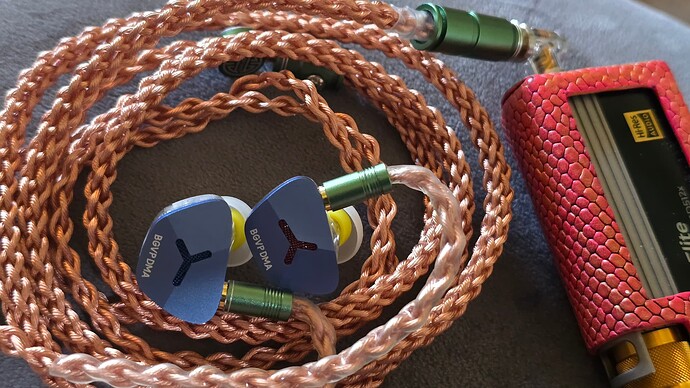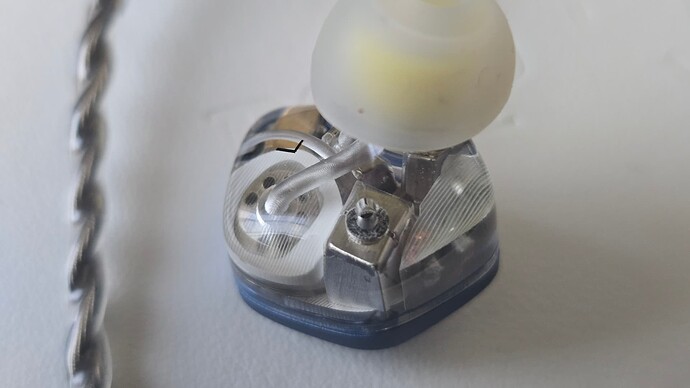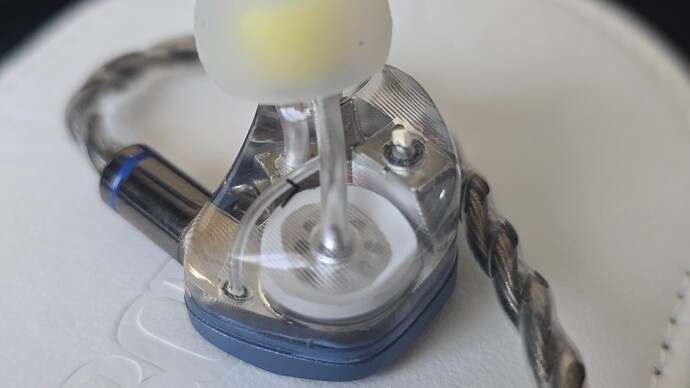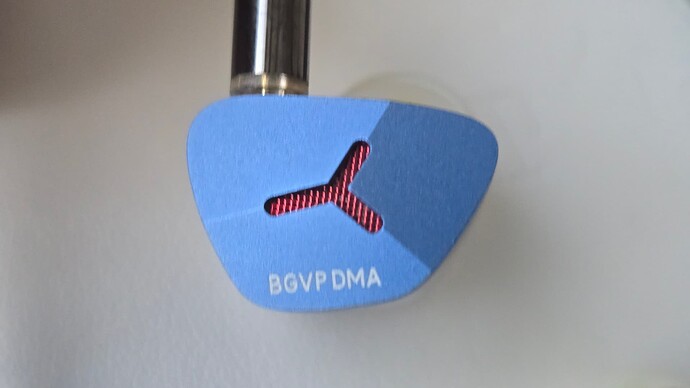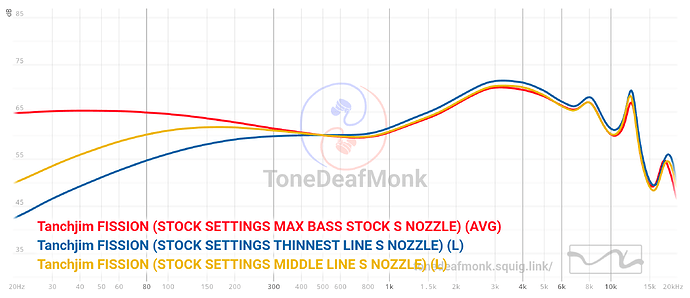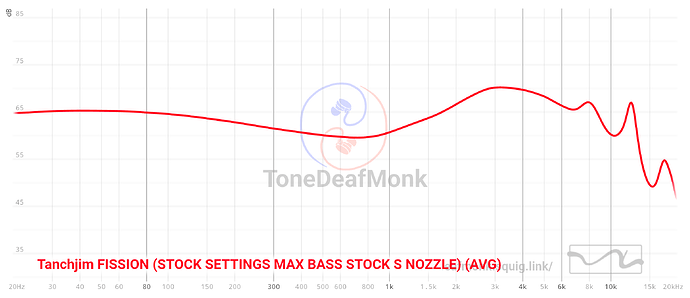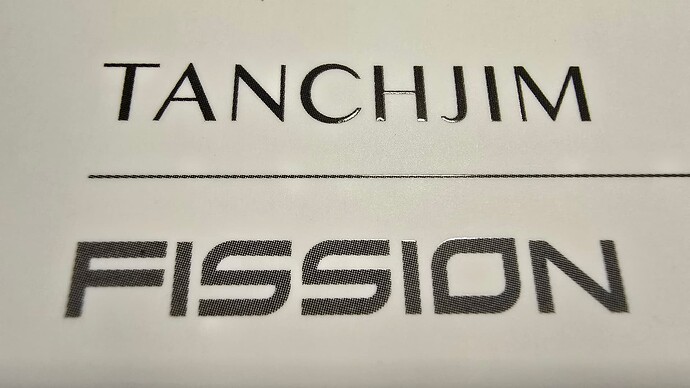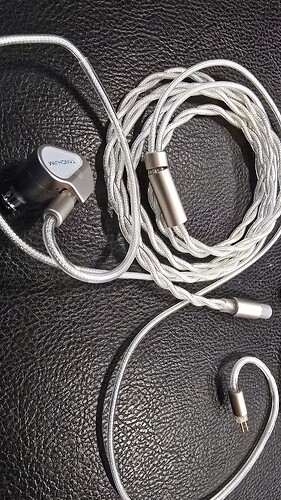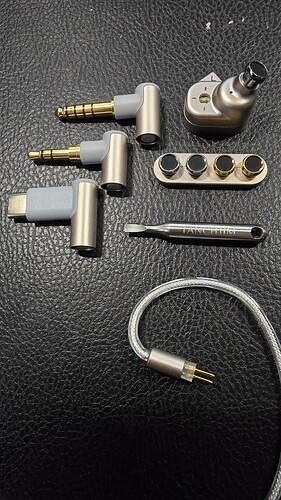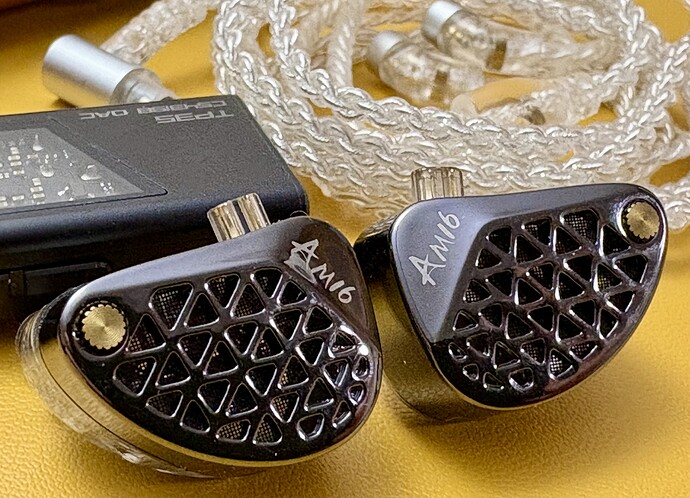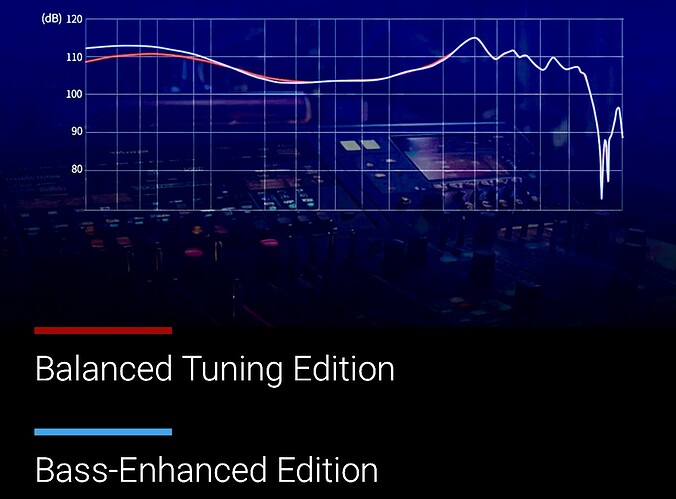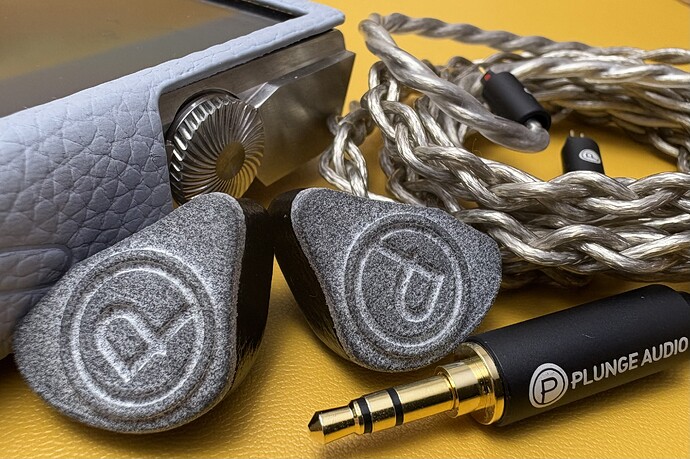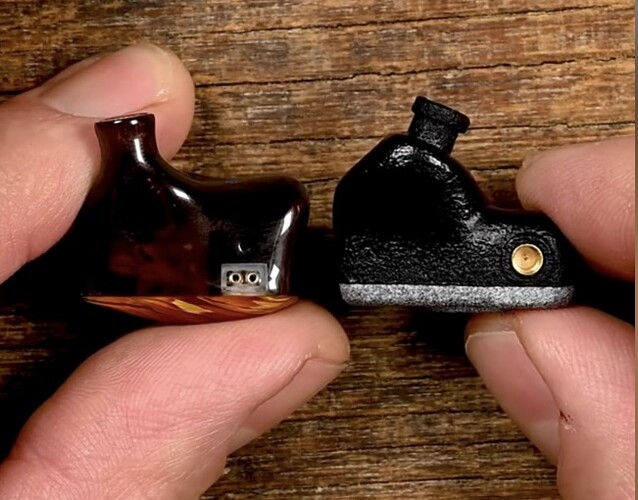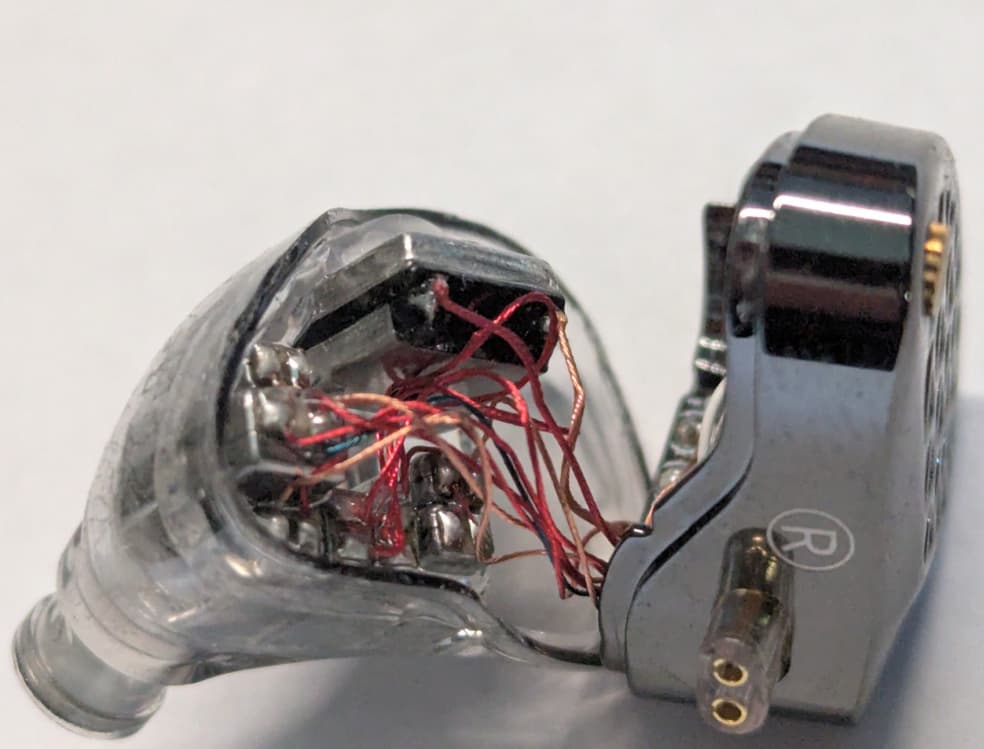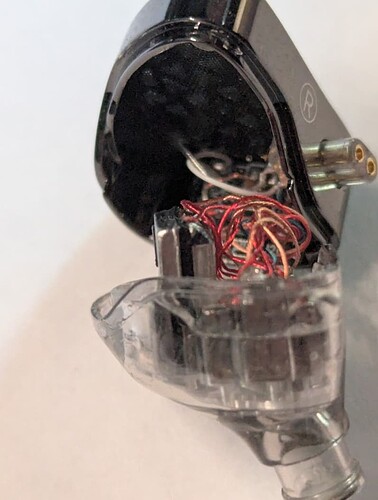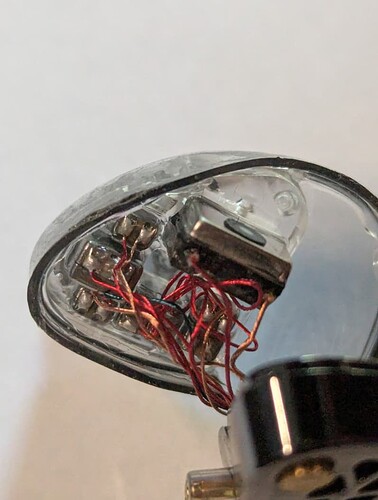I usually paste from an existing Word document but the online editor used by HFG is more limited in compatibility than some other sites usually stripping the formatting even when pasted as “plain text” requiring extra editing on my part. Moving forward I will try and take more time in compensating for those issues with the text.
As for listing sources, I used to do that but may bring it back. I used at least 6 different sources for casual listening but for this review I settled on the Astell&Kern AKHC4 Dongle connected to a PC and the Xduoo XA02 for longer listening sessions.
Mail Call Bgvp Acoustics DMA
This company should be more play!
1x 9.2mm Nickel Plated Dynamic Driver 1x Sonion 2300 Series Balanced Armature Mids ,1x Knowles RAD Balanced Armature Tweeter, 2x Sonion BA Style Bone Conduction drivers vented directly into the Ear.
$299 with the best quality drivers is a great deal ![]()
First Listen now on the IBasso Audio DC Elite is impressive.
I’ll be interested in your comparative comments. I’m liking the Septet though for me it’s not as hot in the treble as the NS10 Pro. I sense more air with the Septet vs raw upper energy that makes the NS10 Pro special. Caveat, my ears top out at 13kHz after that zip.
The energy is in a slightly different place but man does the Septet play a wide stage making it quite special in it’s own right. Imaging isn’t great but the euphonic stage makes me not care at all.
I feel I could just get lost in the sonic landscape more so than my other sets.
Mail call and a shit tonne of confusion ![]()
HiFiGo sent me the new TANCHJIM Fission
Stock tuning looks ![]()
Cable is beautiful, 3.5, 4.4 , USBC ![]()
3 Sets of Nozzels ok fine 1 does a tad less bass and slightly more upper mids and treble ok this all makes sense so far.
Then the wicked looking metal tool to adjust the 4 position bass switch underneath now comes the WTF part.
Why in earth would you want to truncate / castrate the bass by ever a fraction of that?
Good news take it out of the box don’t touch a damn thing with the nozzles or switch and good to go.
I will report back with sound soon.
Edit: first listen yeah Tanchjim didn’t miss with the tuning in stock form.
Thank you for sharing your first impressions! They appear to be even lighter in the bass region than the Bunny, according to the graph!
I would agree with that , letting this set burn in for a few days see if I can squeeze a bit more bass iut of them
Awesome review! That open-back design seems to really bring the mids and soundstage to life. How does it compare on complex, busy tracks versus other multi-driver hybrids you’ve heard?
Doubt its doing much.
KZ AM16
True Open Back IEM’s
Bass Enhanced and Balanced Models.
8 BA drivers per side. $56-$64 usd
-
31736 Dual Array Balanced Armature
-
22955 New Generation Low-frequency Driver for Excellent Bass & Sub-bass
-
30019 Customized Balanced Armature x4
-
29689 Mid-frequency Balanced Armature
-
Frequency: 5-45000Hz
-
Sensitivity: 104 dB
-
Impedance 22 ohm
![]() Preamble:
Preamble:
I purchased these at release with a $10 per set discount offered, $47 usd bass version, $45 usd balanced, no mic.
No idea why the bass sells for $2 more, the IEMs are identical, they’re not even labeled to differentiate between bass and balanced versions.
These will be available to tour with the Canuck Audioholics Review Group.
![]() Unboxing:
Unboxing:
Is typical KZ.
Plain black box with a label on one side displaying the item description and specs.
The Ear pieces.
A few ear tips.
An underwhelming silver plated copper cable smelling strongly of VOC’s.
Terminated 3.5mm.
(the odour mostly vented off in a day or two, but still can’t ignore the smell while listening)
![]() Pros and Cons:
Pros and Cons:
![]() True open back design. You can clearly see light through the IEM, and the music is distinctly audible out the backside.
True open back design. You can clearly see light through the IEM, and the music is distinctly audible out the backside.
![]() Shells appear to be of good build quality. Clear plastic front piece, with what looks to be a formed cavity containing all the BA drivers firing toward the nozzle.
Shells appear to be of good build quality. Clear plastic front piece, with what looks to be a formed cavity containing all the BA drivers firing toward the nozzle.
The metal faceplate is a half shell design.
![]() High Precision PCB crossover.
High Precision PCB crossover.
![]() Underwhelming KZ standard 3.5mm silver plated silver cable with strong smell of VOC’s.
Underwhelming KZ standard 3.5mm silver plated silver cable with strong smell of VOC’s.
Available with mic for a couple $$ more.
![]() Very good BA implementation.
Very good BA implementation.
![]() Excellent staging.
Excellent staging.
![]() At higher (but still safe) volume high frequency BA drivers can start to falter.
At higher (but still safe) volume high frequency BA drivers can start to falter.
![]() Source device compliant, sounds good on every source device I tried.
Source device compliant, sounds good on every source device I tried.
![]() Drives easily with phone and basic dongle. (iPhone and EPZ TP35)
Drives easily with phone and basic dongle. (iPhone and EPZ TP35)
![]() Despite KZ site stating the same specs for both, I do find the Bass Model requires just a notch or two more on the volume wheel to match volume with Balanced Model.
Despite KZ site stating the same specs for both, I do find the Bass Model requires just a notch or two more on the volume wheel to match volume with Balanced Model.
** NOTE: I have shied away from KZ for some time now, mostly because of tuning switches. I’m not a big fan of switches and most of KZ’s releases of late were featuring switches.
When I saw the AM16 were switch free I decided to purchase both bass and balanced, primarily for review purposes.
Spoiler alert: I’m quite pleased with what KZ has offered up in both these IEM.
![]() Equipment:
Equipment:
![]() KZ AM16 Bass and Balanced model IEMs. Both aged 50 plus hours.
KZ AM16 Bass and Balanced model IEMs. Both aged 50 plus hours.
![]() Hiby R4 DAP, low gain, 3.5mm out.
Hiby R4 DAP, low gain, 3.5mm out.
![]() Stock KZ Silver plated copper cable terminated 3.5mm.
Stock KZ Silver plated copper cable terminated 3.5mm.
![]() Eletech Baroque extra wide bore ear tips.
Eletech Baroque extra wide bore ear tips.
![]() Sound:
Sound:
** Sound evaluation is done using the AM16 Balanced. I will note differences for the Bass model.
Balanced Model:
There is a generous amount of bass available on the balance tuned model.
It doesn’t have a BA bass sound, but not quite Dynamic either.
It leans a bit toward “boomy” but sub bass pulls low with good rumble.
Transients are quick so sub bass decays fairly quickly staying in its place.
Mid bass has nice impact and there is good definition between sub and mid bass.
Bass Model.
As per the frequency graph, there is about a 3 maybe 4dB lift in the sub bass area. What you see is what you get. The Bass tune Model is NOT an extreme bass focused skull crusher.
It just adds a nice extra bass lift, and can deliver in impressive amounts, if the recorded track delivers.
Sub bass is less boomy, more rumble, and pulls lower with a more natural sub bass rumble than the balanced. Transients aren’t quite as quick, and, sub bass carries into the mids.
Mid bass retains its nice impact. Sub bass does over ride mid bass a bit, but maintains good sub/mid bass definition.
Balanced Model:
Lower mids are rolled off, mid and upper mids have very good macro and some micro detail retrieval. They present forward and somewhat elevated.
They are clear, detailed, open and spacious allowing for excellent individuality of instruments.
Vocals are crisp and clear with a mostly natural and accurate tonality. Maybe just a touch on the thin side at times.
Bass Model:
The extra bass carries into the mids and takes away some of the open spaciousness and clarity of the staging.
Vocals really benefit from the extra warmth, they are less thin, and gain a nice touch of organic timbre.
Balanced Model:
The high end is clear and bright with very good detail and clarity.
Also nice sparkle and air.
It’s in the highs that I notice occasional faltering in the BA drivers at higher volumes.
It’s either BA timbre becoming noticeable, or, the drivers are starting to distort.
Not a concern at my typical listening volumes.
Bass Model:
The high end pretty much mirrors the Balanced model.
But with more bass presence and warmer mids their presence is less prominent.
All the detail is there, just playing against a warmer background.
Balanced Model:
Staging is excellent.
Width outside the head, very good top to bottom height, and good front to rear depth.
The stage is spacious and open allowing for a sense of individually for instruments and vocalists.
Imaging and layering is precise and accurate.
Bass Model:
Staging is still excellent.
Width, height and depth very much on par with balanced.
The stage is somewhat less open and spacious.
This takes away some of the separation between individual instruments and vocalists.
Imaging and layering are still very good but there is some loss of the pinpoint accuracy of the Balanced model.
Summary:
I think KZ has a pair of winners on their hands.
Both are very well tuned and the BA drivers very well implemented.
I am hard pressed to say which of these two models I will reach for most often.
I like the warmth in the mids, and added “organics” in the vocals of the Bass model.
But also really like the open, spacious stage and more precise imaging and layering of the Balanced model.
Pricing seems to vary a bit, but the KZ site states $59-62.00 usd.
I feel they are easily worth that.
I picked mine up for mid $40’s usd and feel that is a true bargain for well tuned 8 BA driver per side IEM’s.
![]() My music sources:
My music sources:
Qobuz, and, FLAC and DSD files stored on the SD cards of my daps.
My music genre are primarily Rock, Blues, Jazz, Symphonic, Country, Rap, R&B, Pop, Electronic.
Enjoy your music. ![]()
Plunge Audio
UNITY DYNAMIC $269.00 usd
Single DD IEM.
Impedance: 32 ohm @1kHz
Sensitivity: 96dBSPL @ 1mW (IEC 318)
Frequency Response: 10Hz -20kHz
Isolation: -28dB
Drivers: Single 9.2mm LSR Dynamic Driver (liquid silicone rubber)
![]() Preamble:
Preamble:
The Plunge Unity Dynamic is my own personal IEM. It will tour with the Canuck Audioholics Review Group.
This is not a full review, more a commentary and introduction to Plunge Audio’s second IEM release.
The Plunge Unity Dynamic, a single DD IEM.
It follows in the footsteps of the OG Plunge Unity, a 4 BA IEM which is now referred to as the “Plunge Unity Stage”.
![]() A Bit About Plunge Audio
A Bit About Plunge Audio
(There is lots of additional info on their webpage)
Plunge Audio, is a small independent developer/manufacturer/distributor of semi custom IEM’s, focused primarily on the stage and studio market.
The are located in Calgary, Alberta, Canada. And ship worldwide.
Simon Fisk, owner, and driving force behind the Plunge team is a musician with several albums to his credit, and an audiologist, whom originally, was marketing full custom IEM’s.
Due to high cost and lengthy delivery times for full customs Simon developed
And licensed a unique universal shell design, with the in ear stability and comfort of full customs.
![]() Packaging:
Packaging:
The Unity Single Dynamic arrived in a fairly plain cardboard box that doubled as the shipping carton. Environmentally responsible.
** Inside is a very robust oval carry case that could fit in a larger pocket, but designed to be unceremoniously tossed in a kit bag, and go.
** And inside the case; the ear pieces, A silver plated copper cable terminated 3.5mm (4.4mm not available), what appear to be 3 pair Tangzu Tang Sancai ear tips, 3 pair foam ear tips, and a cleaning tool.
The basic essentials, built to last.
![]() Pros and Cons:
Pros and Cons:
![]() The vented “industrial” looking shells are 3D printed nylon which are considerably more robust than resin, and much lighter than metal.
The vented “industrial” looking shells are 3D printed nylon which are considerably more robust than resin, and much lighter than metal.
The upward directional nozzle angle is unique to Plunge and are tailored to fit the ears natural anatomy. (See photo)
The shells incorporate an open chamber/open nozzle design. No tubes, no filters, no mesh, just open room.
Similar, in some ways, to the concept of “room correction” setup on a home theatre system, the driver(s) in the IEM are “tuned to the room”.
![]() The vent in the shell fires directly at the Tragus of the ear.
The vent in the shell fires directly at the Tragus of the ear.
The tragus assists in collecting and directing sounds into the ear, in particular sounds from behind.
These sounds are delayed, which assist us in determining directionality front to rear.
Strictly a personal interpretation, but, I imagine the vented sounds would enter the ear as ambient sound passing by the ear tips, adding dimension to the sound stage.
From Plunge website:
“All while our proprietary tuning and venting system adds air and aliveness around the sound”
![]() 2 year warranty on manufacture defects for shells and internals, and 90 days on cable and case.
2 year warranty on manufacture defects for shells and internals, and 90 days on cable and case.
![]() Each unit is hand assembled, tuned, and packaged.
Each unit is hand assembled, tuned, and packaged.
![]() Ships worldwide, anywhere Canada Post ships.
Ships worldwide, anywhere Canada Post ships.
![]() Unique design and secure comfortable fit.
Unique design and secure comfortable fit.
![]() Staging, imaging, and layering that competes with the best of the best.
Staging, imaging, and layering that competes with the best of the best.
![]() No 4.4mm cable termination available.
No 4.4mm cable termination available.
Equipment:
![]() Plunge Unity Dynamic IEM aged approx. 50 hours.
Plunge Unity Dynamic IEM aged approx. 50 hours.
![]() IBasso DX340 DAP low gain, 3.5mm SE out.
IBasso DX340 DAP low gain, 3.5mm SE out.
![]() Stock silver plated copper cable, terminated 3.5mm.
Stock silver plated copper cable, terminated 3.5mm.
![]() Electech Baroque extra wide bore ear tips.
Electech Baroque extra wide bore ear tips.
I am not a musician, couldn’t play a note to save my life.
I am an audio enthusiast/audiophile, I love listening to music, and have since I was old enough to know there was music.
So why do I own IEMs developed and marketed toward stage and studio use?
I visited Simon at his shop a couple years ago and auditioned the Plunge Unity Stage (4 BA). (Approx. $650 usd)
I was immediately captivated by the uncoloured and honest reproduction of each recorded track that I listened to, and purchased one on the spot.
When I received a notification of the pending release of the Unity Dynamic, I didn’t hesitate to take advantage of the opportunity to pre order and be among the first to experience it.
There is an FR graph in the photos that is from the 4 BA Unity Stage.
There are no FR graphs currently available for the Unity Dynamic, but, this graph will give some insight to Plunge Audio’s “balanced” tuning philosophy.
![]() Sound:
Sound:
Bass on the Unity Dynamic is what the recorded track delivers.
Hit it with some sub bass heavy electronic and pour the coal to the volume and it pulls low with an authoritative rumble that will vibrate your cranium.
Switch to some jazz and the double bass is clean and natural and just the right amount.
Mids are filled with macro and micro detail. The recorded track determines positioning on stage.
Sometimes a bit forward and elevated, other times laid back and a little subdued, but never over emphasized.
Vocals are tonally accurate on both male and female.
As with the mids, the track determines positioning on stage.
Highs have excellent micro detail retrieval, air, and sparkle. Never harsh
Staging is open and spacious with a dead silent background. (Source device may impact this)
Imaging and layering are precise and accurate on all three axis.
On par with, or better, than any staging I have heard.
![]() Summary:
Summary:
So who are Plunge Audio Dynamic IEM’s for”
Obviously for the main target market, musicians and studio techs.
But also for audio enthusiasts who want a clear, mostly uncoloured, accurate and natural reproduction of the recorded source with incredible staging, tonality and timbre.
Compared to the all BA Stage edition I find the Dynamic a bit looser and less defined in the bass region, and less mids forward in the mids and vocals.
The all BA has a little more individuality between the frequency ranges with 4 drivers handling the work load instead of one.
IMHO I feel the Dynamic is the better choice for audio enthusiasts.
It is a highly technical IEM, with good “musicality”
The Plunge Audio Dynamic is an extraordinary IEM well worthy of consideration by those in the music industry, and, audio enthusiasts who feel the tuning suits their listening style and preference.
I’m enjoying it immensely.
![]() Enjoy your music.
Enjoy your music.
Great to hear nice that KZ is still king of budget and good ![]()
Mann this was refreshing! A proper open back IEM! and it seems to be exactly how i thought an open back set might sound like. I am not too big on spacious stages BUT this does feel like something i would atleast wanna give a try.
Just gonna mention that the AM16 is NOT a true open back as the only driver with the cavity linked to the faceplate vents is the woofer, the other ones are not (they are sealed drivers) and its effectively not an open back because of that.
(not my pics its from someone in my discord server.)
Appreciate the clarification. ![]()
![]()
There is a full range of sound comes out the back and the staging is so good I thought they were likely open back.
I did have ?? Marks behind the open back comments in my review, but I see I missed them on this post.
I see it has now been clarified.
I was going to mention I wasn’t 100% sure they were open back, but certainly had the markings of one, full range of sound from the back plate, and excellent staging.
Bass version has a somewhat less open stage.
its just less damping between which is why you hear it leaking from the “front”.
Play any iem at loud volumes and block the nozzle and you still hear it.
Has anyone compared the AS16 Bass to the KZ Zenith 1111? Encouraged by the review, I ordered them and I’m curious if the BA will sound better than the DD.
The Zenith has a bit too little bottom even in the 1111 setting.
Good luck. I’ve not heard a BA that even comes close to a cheap DD let alone a good one
As for bass, yes, and the rest, midrange and treble? 6BA won’t give a higher resolution than 1DD?
